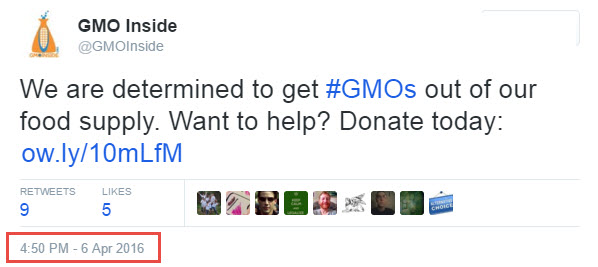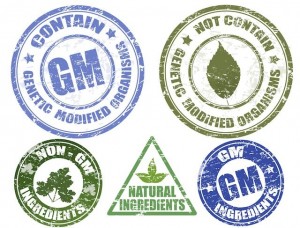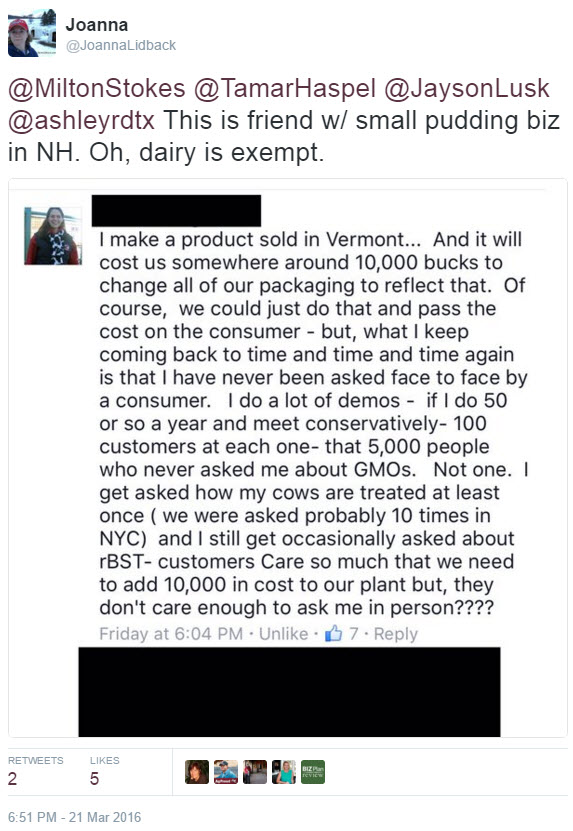Here at Biology Fortified, we’ve got a lot of projects going on. From databases of research, to infographics, blog posts, citizen science and more, we do what we do because we love science and we want more people to understand and appreciate it as well. We have only been able to accomplish what we have thanks to support from our readers and fans, as well as a couple small competitive grants. In the past year, we introduced a monthly membership program that enables us to have the resources to sustain this work and start bigger projects. Continue reading “Cooking video series to launch!”
Tag: Food
Six real consequences of GMO labeling – you may be shocked by #5!
Labeling of genetically modified organisms in food has been debated for decades now. Whether the labels should be mandatory, voluntary, or third-party based like Kosher has been widely disputed. For a long time we’ve all discussed what would happen if/when GMO labels hit the stores. Some groups claimed that there was no cost at all to just label food. Other groups predicted serious impacts on the budgets of consumers. Due to the looming Vermont legislation which will take effect on July 1st, we are beginning to see the reactions by food producers and distributors. We don’t have any data yet on how consumers respond, but we can examine what the companies are doing at this point.
Every tidbit so far has been an example of “told you so”. Some companies are embracing their GMO supply chain and doing the charm offensive. Some are swapping out ingredients. Some are raising prices. Some are eating their price differences (which, of course, will hurt small business the most). Some may simply opt-out of selling in the Vermont market.
Things may shift was we get closer to the deadline, or change completely if the court battles resolve. But here’s what we know about the current state of play. Here are six real consequences of GMO labeling:
1. Labeling is “expensive”.
Campbell’s was the first company to go public with their plans, in this piece from the NYT. They will now label all their products across the US, because labeling for 1 state was not workable for them–and would be “incredibly costly”. The Chief Executive of Campbell said about their own program, “Ms. Morrison said that complying with Vermont’s law was expensive….” No, it’s not just some text on the can. It’s reviewing the supply chain, checking all the recipes, evaluating the logistics, exploring sourcing options, etc. Anyone who tells you it’s just a bit of text has no grasp of this, nor of the $1000/day penalty for getting it wrong. Small producers are acutely aware of how much the changes will cost them (in the example here that’s $10,000). Their budgets are far less flexible than those of Big Food, and it will be hard to know if some of them just choose to stop selling into that market.
2. Labeling is confusing.
In the same NYT piece, we find that plain SpaghettiOs must carry a GMO label. But meatball SpaghettiOs do not need to. Since they are regulated by different agencies, meat-containing products are exempt. How this adequately informs consumers has yet to be adequately explained to me. I’m sure someone will try in the comments. We also know that the state of Vermont can’t handle the incoming questions at this time, and according to a Wall Street Journal piece: “The office of Vermont Attorney General William Sorrell, which is responsible for enforcing the state law, has been deluged with questions. Its website now warns that the office won’t reply to email inquiries about GMO labeling and asks companies to stop calling.” That’s informative.
3. Companies will swap out ingredients.
The same WSJ piece above included reports of a small pasta business that had to make changes to their recipes to avoid the labeling hassles and possible penalties. They had been using canola oil–which may be herbicide tolerant GMO, or herbicide tolerant non-GMO. Surely even if they were using the non-GMO version but people saw it on a label, the tractor-chasing legal teams would light up with glee. In any case, they have now switched to olive oil. This raised their costs by 10%, without a similar increase in sales. Other small companies are retiring some products (how’s that for choice?). Maybe Big Food can eat those kinds of costs, but this hurts a small business.
And that said, if you actually think Big Food doesn’t pass the costs along in some way, I’d like to sell you this charming Vermont GMO-free covered bridge….
4. Swapping out ingredients raises prices.
We know this from Ben & Jerry, in fact. Interestingly, in early comments on this, B&J said: “Ben & Jerry’s has no plans to raise prices as a result of the transition….” Later we learn, also from the WSJ article: “It took about three years just to remove GMOs from ingredients like cookie dough and caramel, and the new products averaged 11% higher in price.” About that bridge, my prices just went up.
5. Changing recipes alters products – in unpleasant ways.
Besides some products simply disappearing due to the hassle of finding new sources, other products may get modifications to avoid GMOs with surprising results. We’ve watched multiple examples of products losing vitamins as they got their Non-GMO Project status. In the case of not-Heath-Bar-Crunch, customers were dismayed by the new flavor.
I have to say, though, the most surprising thing to me was adding new allergen labels as a result of their switch. One company switching away from cottonseed oil has opted for peanut oil: “that switch introduced a new allergen the company had to warn consumers about.” Swell. If you have an allergy as I do, you’ll have to be aware of ingredient changes to products you’ve bought all along. Let’s hope that parents of kids with allergies don’t miss these changes because their kids could get hurt.
6. Some companies will opt out of shipping to Vermont.
An article by the Associated Press covered another aspect of the challenges: shipping. One company was facing serious logistical issues, which are also costly.
Herr Foods Inc., a midsize snack food company based in Philadelphia, is considering pulling its products from Vermont if the law takes effect, said Daryl Thomas, senior vice president for sales and marketing. “Just the logistics, the expense are horrendous,” he said.
And this doesn’t include the costs of getting it wrong, with the very steep penalty and ensuing the legal nightmares. Yeah, labelers want choices. The choice to remove other people’s favorites. In addition, small shop owners are losing sleep over the downstream consequences of opting-out:
“As a retailer, there’s all sorts of ways that this could backfire on us as a state, and a small independent guy like myself if I’ve got nothing on my shelves or I’ve got limited (supply) and my competitors have no problem with the staying power, we’re done,” said Ray Bouffard, owner of Georgia Market in Georgia, Vermont.
Again, we see that small business stands to be harmed by the whole scenario. And Big Food and Big Chain probably continue to swim in the shark-infested waters. Is that what labelers wanted? Really? A win for the Bigs? Well done.
These are the known issues. Other unknowns at this point include the impacts on sales, legal penalties, enforcement costs, and other financial effects. Another possibility is harassment of companies. “Some of the feedback that these companies are getting is boycotts from groups against the use of GMOs…”. We’ll have to assess this on the real roll-out, but I’ve known this was the goal all along. If you think that labels are going to stop the shouting, see me about that bridge again.

- Update 6/27/2016: Coca-Cola will not ship some products to Vermont after July 1.
- Update 6/30/2016: Products disappearing, confusion ensues. I don’t hate to say “I told you so.”.
- Update 7/1/2016: Labeling day! Price Chopper loses 3,000 products over GMO law.
- And here’s Bernie Sanders using a QR code.
- Update 7/2/2016. Consequences continue to roll in. Baby formula is becoming unavailable.
- Update 7/10/16: Reduced access to Kosher foods being reported: “Afek also confirmed the expense associated with complying with the Vermont law is considerable.”

Is HR 1599 the SAFE Act or the DARK Act?
The SAFE act (Safe and Accurate Food Labeling Act) or HR 1599 seeks to regulate labeling of GMOs. It recently passed the House and is currently in the Senate. In this post, I’d like to explore the highlights of the bill and outline my thoughts on why some organizations are opposing it. Continue reading “Is HR 1599 the SAFE Act or the DARK Act?”
Why do GMO science communication?
If you’ll permit me, I’d like to philosophize a bit about why I am here, why I keep coming back to science communication. Now that I have a young daughter, I often ask myself how I can best spend my time. Even more so as I read the heartbreaking news of refugees leaving war torn Syria, horrifying gun violence in the US, the dismal state of US politics… I have to tell you that talking about GMOs has seemed like a waste of time for a while now. The science is in, the technology is safe. We can talk about specific use of the technology but those details are so small compared to the huge problems in the world. Still, while these “food fights” feel meaningless compared to so many issues facing the world today, I think we do need to keep on talking.
I think science communication about GMOs and other issues in food and agriculture is necessary for one short term reason, one medium term reason, and one long term reason. Continue reading “Why do GMO science communication?”
Marching against Chipotle’s GMO myths

Today, Chipotle Mexican Grill is putting on a show in Minneapolis. Their Cultivate Festival is a public relations event that combines food, drink, music, chefs, and myths served with a side of fear, I mean guac. Attendees can choose to walk through four information booths with the promise of a free burrito at the end, which sounds great except these booths contain carefully crafted and misleading invectives against food, farming, and science. In response, the March Against Myths (MAMyths), a grassroots movement whose mission is to combat myths with facts, penned an open letter to Chipotle to ask them to correct the false and misleading statements they make about genetically engineered crops (GMOs), which was received, acknowledged, and ignored. Today, MAMyths is coming to the Chipotle Cultivate Festival to correct the misinformation and be a resource for the public to learn more about GMOs. Today, we’re marching against Chipotle’s GMO Myths. Continue reading “Marching against Chipotle’s GMO myths”
Deathmatch: Conventional Breeding vs Transgenesis
“Mutation. It is the key to our evolution. It has enabled us to evolve from a single-celled organism into the dominant species on the planet. This process is slow and normally taking thousands and thousands of years. But every few hundred millennia, evolution leaps forward.” – Professor Xavier
I love that quote from X-Men.
Other than the last sentence, it’s true. Mutations happen at a fairly constant rate and can occur every time a cell divides. Although we tend to think of mutations as negative events associated with genetic diseases or cancer, some mutations are beneficial: in our species, mutations have allowed for adaptation to high altitude in Tibetans or have protected individuals from heart disease. The same is true in nature: mutations allow for plants to develop resistance to pests, or in the case of weeds, to pesticides.
However, as Professor Xavier points out in the opening credits of the movie, the process is slow. So how can we “force” beneficial mutations to occur quickly? In crop development, we’ve been forcing mutations to happen by a process known as “mutagenesis“, where chemicals or radiation are used to create random mutations generating new traits. Continue reading “Deathmatch: Conventional Breeding vs Transgenesis”
Comment Today on the next Genetically Engineered Potato

There’s always a little catch-up to do when coming out of the Holiday season. Back in December, the USDA public comment period opened up for a next-generation transgenic potato variety developed by Simplot. The previous Simplot “Generation 1 Innate” potato, which reduced browning, acrylamide, and bruising, was approved by the USDA in November last year. Back in 2013, we conducted an interview with Haven Baker at Simplot to find out answers to your questions about the potato and its new traits. Now they have another potato variety with more traits – Generation 2 Innate – which takes the traits of Generation 1 and adds late blight resistance and further reduces the acrylamide-generating potential of the tubers when you fry them.
There is a lot to discuss about this new variety and its traits, however, the first public comment period for USDA regulations ends today! I wanted to inform our readers about this deadline in case you wanted to submit a comment to this round, and I was able to obtain some more information about the traits from Erik Gonring, who manages Industry Affairs at Simplot. There will be more opportunities in the future to do an interview as we have done before, and feel free to start a discussion below. Indeed, there will be a public comment period for the EPA’s review of the second Innate potato. Continue reading “Comment Today on the next Genetically Engineered Potato”
The day I unwittingly became a pro-science activist
Written by Jeff Fountain

Early this September I attended the National Heirloom Expo in Santa Rosa. It’s an event that’s centered around the pure food movement, heirloom vegetables, and anti-GMO activism. The speakers included Joseph Mercola, Jeffrey Smith, Andrew Kimbrell, and my personal favorite pseudoscientist, Vani Hari, a.k.a. the Food Babe. For those unfamiliar with Food Babe, she is an anti-GMO, pro-organic public figure who attacks food and agricultural companies for what are essentially harmless practices. The reason I mention her is because she inspired me to start my own Facebook parody page called Food Hunk, which is what sort of drove my foray into ‘activism’. Food Hunk is to Food Babe, what Stephen Colbert is to Bill O’Reilly. I joined a community of other wonderful Food Babe critics such as Chow Babe and Science Babe, with my page being a bit of a broader commentary on fallacious ways of thinking, such as the all-too-common naturalistic fallacy.
I’ve been interested in science all of my life, but only in the last few years have I become more involved with skepticism and the idea that you don’t need to be a scientist to think like a scientist. As usually proliferated on social media, a constant barrage of anti-GMO fear mongering flooded my Facebook feed on a daily basis. I started trying to counter these claims with sound science. Because many of those spreading erroneous info were good friends, I felt compelled to actually know what I was talking about and inform them, instead of simply calling them out their ignorance. I became active in various online forums devoted to exploring the issue of genetic engineering, and found myself learning from some of the best science communicators on the topic. Upon realizing that I couldn’t learn enough, I decided to go back to school and learn about biotechnology. I’d recently left my fifteen-year career working in the wine industry and was exploring my passion for science. My wife found a certificate program at CCSF called Bridge to Biosciences where I am enrolled today. I am nowhere near as educated as many of the people I correspond with about science, but I’m always trying to learn and never pretend to wield knowledge I don’t have. In my opinion, this is one of the most important components of skepticism. If more people only stopped pretending to know what they do not know, we wouldn’t see the blatant misinformation that so predominantly surrounds the topic of GMOs.
Recently I was in a GMO enthusiast forum, when I noticed a post from Karl at Biology Fortified. He mentioned the Heirloom Expo and was asking if anyone from the Bay Area was going to attend. Santa Rosa is only about an hour from where I live, and so after realizing I didn’t really have anything planned for the day I thought, “How could I possibly pass up the opportunity to introduce Food Hunk to Food Babe?” I put on my ‘I love GMOs’ t-shirt, (carefully concealed under my sweatshirt) and hit the road to Santa Rosa. Continue reading “The day I unwittingly became a pro-science activist”
Let’s make Music for Cooking with Frank N. Foode™!

As many of you may have heard, following the unboxing of our Frank N. Foode™ and Papaya plushies, we have placed the order for these plushies and the factory is beginning production. Not only that, but we managed to increase our order from the original 500 Franks and 250 Papayas to 750 Franks and 500 papayas! The tremendous amount of support and enthusiasm that we saw in our Kickstarter campaign and while we perfected the new designs has been phenomenal, and I personally can’t wait to get the boxes ready to ship as soon as the plushies arrive!
We know that Frank N. Foode™ is going to be a hit, and he will help us reach more people and make science more fun for them. Right now we are preparing to launch Frank into a whole new domain with cooking videos and science festivals – and to do that we need to make music! And we’re going to need your help. Continue reading “Let’s make Music for Cooking with Frank N. Foode™!”
Edible Education 101 and GMOs
Last week, Dr. Pam Ronald gave a lecture about genetically engineered crops in Michael Pollan and Raj Patel’s Edible Education 101 class. After the 1-hour lecture, she sat down with Pollan and Patel to debate and discuss the issue. The New Yorker wrote a story about it, and now you can watch the video!
Dr. Ronald surveyed the students in the class during the lecture which had some interesting and dramatic results.
What did you think? Let’s discuss it in the comments.











